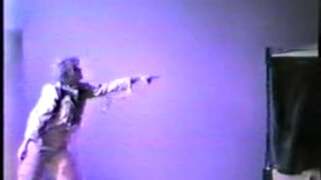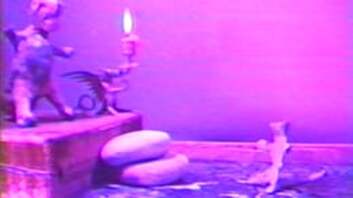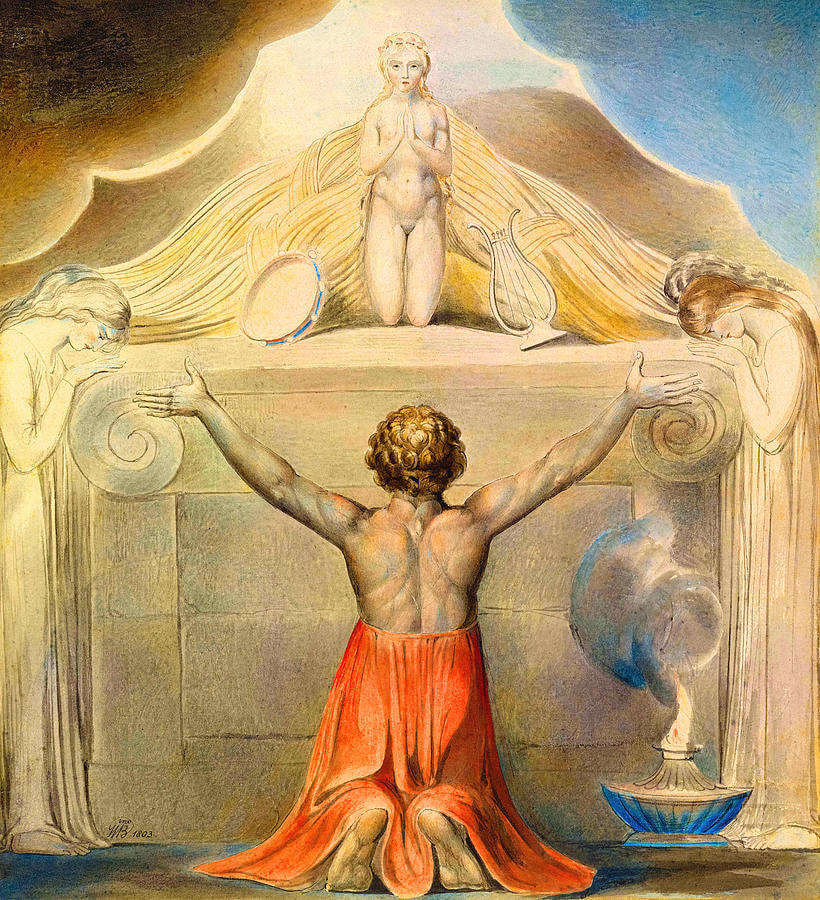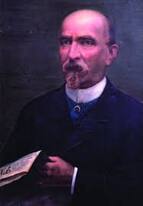Book I: Symphony Ballets: (see listings in Volume III, Book I, Orchestra)
1. Symphony # 1. Scaramouche et Pulcinella:
30 minutes & 35 seconds: ballet: 7 movements; after the poem "Fantoches" by Paul Verlaine (photo below, left). A magician makes puppets come alive: they love, have wars, are wounded and die. Then they wish for things to be as they were. The idea that this poem should be used as an orchestral work was first suggested to me by Dr. Anna Balakian, the chairwoman of the comparaitve literature department at New York University (photo below, right). Unperformed; See IV/I/3.
1a. Scaramouche et Pulcinella: 2/2/2/2 2/2/2/1 percussion, timpani and strings; woodwind/string octet is prominent. See III/Ib/1.
1b. Scaramouche et Pulcinella: Synthesized realization by Michael Rafferty; cablecast on BNN-TV with the futuristic play: "Now and Then" featuring actors, TJ Norris (photo below, center) and the composer. Temporarily lost. See II/IIId/2.
1c. Scaramouche et Pulcinella: flute, clarinet, violin, 'cello and piano. In preparation for performance, with clarinetist, Romualdo Barone, at The Aichi University of The Arts, Nagakute, Japan. See I/III/3.
1d. Scaramouce et Pulcinella: original version for octet of woodwinds and strings: 1/1/1/1 1/1/1/1: I/VIII/2. Unapproved doctoral thesis at Boston Univeristy. Unperformed.
30 minutes & 35 seconds: ballet: 7 movements; after the poem "Fantoches" by Paul Verlaine (photo below, left). A magician makes puppets come alive: they love, have wars, are wounded and die. Then they wish for things to be as they were. The idea that this poem should be used as an orchestral work was first suggested to me by Dr. Anna Balakian, the chairwoman of the comparaitve literature department at New York University (photo below, right). Unperformed; See IV/I/3.
1a. Scaramouche et Pulcinella: 2/2/2/2 2/2/2/1 percussion, timpani and strings; woodwind/string octet is prominent. See III/Ib/1.
1b. Scaramouche et Pulcinella: Synthesized realization by Michael Rafferty; cablecast on BNN-TV with the futuristic play: "Now and Then" featuring actors, TJ Norris (photo below, center) and the composer. Temporarily lost. See II/IIId/2.
1c. Scaramouche et Pulcinella: flute, clarinet, violin, 'cello and piano. In preparation for performance, with clarinetist, Romualdo Barone, at The Aichi University of The Arts, Nagakute, Japan. See I/III/3.
1d. Scaramouce et Pulcinella: original version for octet of woodwinds and strings: 1/1/1/1 1/1/1/1: I/VIII/2. Unapproved doctoral thesis at Boston Univeristy. Unperformed.
Paul Verlaine, poet TJ Norris, artist & actor Dr. Anna Balakian, writer
2. Clover Ceres: 19 minutes; ballet; 6 movements; 2/2/2/2 2/2/1/1 percussion, timpani & strings. Illicit love is prosecuted; a jail break brings freedom. Unperformed. See III/Ib/2.
2. Clover Ceres: 19 minutes; ballet; 6 movements; 2/2/2/2 2/2/1/1 percussion, timpani & strings. Illicit love is prosecuted; a jail break brings freedom. Unperformed. See III/Ib/2.
|
3. The Great Liberator: 44 minutes: ballet;
7 movements; A woman frees the enslaved, is caught by the evil collector, and eventually is saved by love. Loosely based on an Islandic folk tale, & a dream by JS. Finished in 2023. Unperformed. 3a. The Great Liberator: 2/2/2/2 2/2/1/1 perc/timp. harp & strings. See III/Ib/3; 3b. The Great Liberator: original version for w. w. & string octet (withheld); 3c. The Great Liberator: piano. II/IIId/3. Please click on Drew's artwork to the right to see the score to ""The Great Liberator." |
The Great Liberator
|
4. Symphony # 4: Scrooge: A ballet for New Year's Day according to Deborah Cash, of the Boston Globe. Scrooge sees ghosts & becomes a better person. Based on "A Christmas Carol" by Charles Dickens (photo to the right.) Please see I/V/3, II/IIId/4, & IV/Ib/4.
4a. Scrooge: medium orchestra 2/2/2/2 2/2/1/1 4-9
perc., pno., hrp., & strings. 67 minutes. 6 scenes, completed, January of 2024. Unperformed in this version.
4b. Scrooge: chamber version for: piano, harpsichord, harp, percussion, & solo viola. 50 minutes. Comissioned & performed by The Copley Square Ballet at The Strand Theaterin Dorchester, MA. Choreographed by David Drummond (photo below, left). Drummond was also Scrooge; Nancy Angelini, was The Spirit of The Future (photo below, Book III, left). The Dance Mistress was Zabelle Margosian (photo below, right). Musicians included Angelo Mammano, piano; & Michael Rafferty, harp. Dedicated to Mr. Drummond, the musicians, and the dancers of The Copley Square Ballet. see also 1/V/3.
|
4a. Scrooge: medium orchestra 2/2/2/2 2/2/1/1 4-9
perc., pno., hrp., & strings. 67 minutes. 6 scenes, completed, January of 2024. Unperformed in this version. 4b. Scrooge: chamber version for: piano, harpsichord, harp, percussion, & solo viola. 50 minutes. Comissioned & performed by The Copley Square Ballet at The Strand Theaterin Dorchester, MA. Choreographed by David Drummond (photo below, left). Drummond was also Scrooge; Nancy Angelini, was The Spirit of The Future (photo below, Book III, left). The Dance Mistress was Zabelle Margosian (photo below, right). Musicians included Angelo Mammano, piano; & Michael Rafferty, harp. Dedicated to Mr. Drummond, the musicians, and the dancers of The Copley Square Ballet. see also 1/V/3. To watch the ballet Scrooge in its chamber ensemble version, 47 minutes, 6 scenes, with the orchestra score; please click on Marley's Ghost or Dickens to the right: |
Charles Dickens, novelist
Scrooge, The Ballet
|
4c. Scrooge: orchestral score. 50 minutes, 6 scenes. Created in December of 3023 to accompany the dance video. Unperformed in this version. Please see II/IIId/4.
4d. Scrooge: piano version of original chamber version. Unperformed in this version; withheld. Please see II/IIId/4.
4d. Scrooge: piano version of original chamber version. Unperformed in this version; withheld. Please see II/IIId/4.
David Drummond, Scrooge/choreographer; Zabelle Margosian, Dance Mistress
5. The Wood Sprite: 11 & a half minutes; ballet; 2/2/2/2 2/2/1/1 2 perc., timp.,& str.. A little girl is lost in the forest until The Wood Sprite shows her the way home. Unperformed. See III/Ia/4.
Book III. Dance with Various Instruments: (See III: orchestral)
1. Time: 3 minutes; I wrote this piano piece at age 17. It was later used as the first movement of my "String Symphony II" III/VI/2a. "Time" was choreographed by Nancy Angelini (below). She performed "Time" with Joe Polcaro and "Music Now & Now Dance" at The Villa Victoria Boston's South End. The Pianist was Eileen Feldman. Dedicated to the three performers.
5. The Wood Sprite: 11 & a half minutes; ballet; 2/2/2/2 2/2/1/1 2 perc., timp.,& str.. A little girl is lost in the forest until The Wood Sprite shows her the way home. Unperformed. See III/Ia/4.
Book III. Dance with Various Instruments: (See III: orchestral)
1. Time: 3 minutes; I wrote this piano piece at age 17. It was later used as the first movement of my "String Symphony II" III/VI/2a. "Time" was choreographed by Nancy Angelini (below). She performed "Time" with Joe Polcaro and "Music Now & Now Dance" at The Villa Victoria Boston's South End. The Pianist was Eileen Feldman. Dedicated to the three performers.
|
Time as recorded by Eileen Feldman, & was
used as the soundtrack for "Dinos in Space" as cablecast on BNN-TV as part of "Crazy Dinosaurs." To watch "Dinos in Space" please click on a dinosaur to the right: |
2. Billy Goats Gruff: 6 minutes; based on a Norwegian fairy tale collected by Peter Christen Asbjørrnsen and Jørgen Moe (below, right) in their "Norske Folkeeventyr"
|
This piece may be used for dance. Versions available for string orchestra with percussion III/IV/2a; concerto for 3 double reed instruments and orchestra III/IIb/4; string quintet I/V/5 and the original piano solo, dedicated to, and premiered by Carmen Rodriguez-Peralta II/IIIc/2. The recording was used as the sound track for "The Train" which appeared on BNN-TV as part of "Crazy Dinosaurs." Please push on the train or a dinosaur to the right, to hear Ms. Rodriguez-Peralta's performance of this piece: |
|
The Lovers: 17 & a half minutes; 6 movements; based on the myth of Orpheus & Eurydice, with a happy ending. Inspired by "The Lovers" by Marc Chagall. Please see I/II/7-10 & III/IIc/1-4.
1a. Flute Concerto: with percussion, timpani and strings 9/1-2/23; Alto Flute Concerto, withheld. 1b. Flute Concerto: with piano. 2a. Oboe Concerto: with percussion, timpani and strings; 2b. Oboe Concerto: with piano; in Spanish. 3a. Clarinet Concerto: with percussion, timpani and strings; |
The Lovers by Marc Chagall
|
3b. Clarinet Concerto: with piano; written for Christian Contreras.
4a. Viola Concerto: with percussion, timpani and strings;
4b. Viola Concerto: with piano; the viola concerto is the original version. It is a whole step lower than the other 3 concerto ballets; written for my husband, Drew Hubbard.
4a. Viola Concerto: with percussion, timpani and strings;
4b. Viola Concerto: with piano; the viola concerto is the original version. It is a whole step lower than the other 3 concerto ballets; written for my husband, Drew Hubbard.
Book III. Vocal Ballets (see VII. Vocal & VIII Music Theater):
|
IIIa. Vocal Ballets with Orchesta or Piano:
1. Orpheus in The Underworld: 15 minute of cycle of 7 for low voice; Text, in Latin, by Boethius.This version has an unhappy ending. See V/I/I. This could certainly be done as a dance piece; see V/I/1. 1a. Orpheus in The Underworld: with percussion, timpani and string orchestra. 1b. Orpheus in The Underworld: with orchestra: 2+/2+/2+/2+ 2/2/2/1 percussion, timpani, celesta, harp and strings. |
|
1c. Orpheus in The Underworld:
with piano; cablecast under the name "Eurydice" as part of "Crazy Dinosaurs" on BNN-TV, with DEW performing the music. To watch "Eurydice" and see the orchesral scores for several of the songs please click on Boethius, or a dinosaur to the right: |
Boethius, poet/philosopher
|
Pluto & Orpheus in Eurydice
|
2. Remembrance of Love's Death: 20 minute cycle of 11 songs;
Emily Dickinson (uc); see III 2a. Remembrance of Love's Death: for low voice with orchestra: 2/2/2 2/2/1/1 harp, perussion & strings. See the same selections in Volume III, Book ViII. 2b. Remembrance of Love's Death: for low voice with piano. 9 of the 11 songs were performed by the composer with pianist, Eileen Feldman at 1st and 2nd Unitarian Society, Boston. Please click on Eileen Feldman to the right to hear the premiere: |
Eileen Feldman, pianist
|
|
IIIb. Solo Vocal Ballets:
1. The Cool Valley: 14 and 3/4 minute cycle of 10 songs; 7 songs were performed by the composer at The Boston Public (BPL). The cycle (2022) chronicles a love affair that takes place at several locations in Ireland culminating in a storm at Fontana Beach. The conclusion of the cycle is unclear, but somehow things have changed; was there a death or break up, or perhaps the acceptance of true love? Either a happy and sad interpretation is possible. Please click on Cabra to the right to see a list of all of the Joyce poems set by this composer. |
Cabara, mentioned in the cycle
|
|
IIIc. Solo Vocal Jazz Ballets: 1. The Mystery Caller: 19 minutes; 5#s N & mimes, Bb, synthesizer & piano, music performed by the composer. Fuzzy, a gay man (composer, mime) receives erotic musical phone calls from a mystery caller (Leonard Diggins, mime). The video is narrated by Fuzzy's lover (John Kristensen) Cablecast on BNN-TV & censured (moved from 6 p.m. to 1.30 a.m.) and, as a result, it was shown at Mobius in a show of censured works. You have to be over 18 to see this work. It can be seen in "Activism" by clicking on Fuzzy to the right. 2a. The Search for Mr. Big: 10#s; a 20 minute jazz song cycle for Bb & piano. A gay man falls for a large man. Contains 1 more song than the video below; omits 2 instrumentals. 2b. The Search for Mr. Big: 10#s: a 20 minute video for Bb & synthesizer with 3 actors. The work chronicles two of the large men loved by a gay man, played by Brian Mark. Both of his boyfriends are played by Tony Stegal. Jimmie York plays the mother of one of these men & the land-lady of the other. Shown informally at The Boston Ramrod. Music performed by the composer. To see the story of the love of Tommy and Harold please click on Harold's mother to the upper right; to see the story of Tommy and Paul, please click on Paul or Tommy to the lower right: |
Fuzzy; Plase click on Fuzzy
to visit "Activism" Jimmie York as Harold's Mother
Tony Stegal as Paul,
with Brian Mark as Tommy |
Book IV: Cantata Ballets (see IV. Choral & VII. Opera):
|
1A. Ample Make This Bed: Set in the 1980s, this is the story of two gay men, one of whom contracts A. I. D. S.. 1B. Covid-19: Completed in April of 2020 during the covid-19 pandemic, and set in 2020, "Covid-19" is the story of two lovers, who are again referred to simply as A and B. Please click on Emily Dickinson to see a list of her poems that have been set by this composer. |
Emily Dickinson, poet
|
1A. Ample Make This Bed versus 1B. Covid-19: Other than the change of time and malady the two versions are identical; however, the political implications of 1A. are much more powerful than those of 1B. However, since 1B involves a more recent pandemic it might be seen as more relevant. 1B may also be more comfortable for conservative audiences.
See also VII/III/1. Both versions incorporate around 50 poems by Emily Dickinson, in the public domain. Both versions are in three parts:
Part I: Love: The couple meets and they fall in love. A is extremely taken with B. However B is wildly flirtatious (with C and perhaps other dancers) and B acquires covid-19. How far this "flirtation" goes I leave to individual producers.
Part II: Nature: B is asymptomatic and transmits the virus to A.
Part III: Immortality: A eventually dies as a result, but returns as an Angel. Along the way, the couple deals with betrayal, redemption and resurrection.
The Singers and Dancers: In the original version both A, B, the trios and choruses were all conceived as male. Gender makes no difference in the Covid-19 version. In this case. and the vocal parts can be performed by women up an octave. Both A and B co-respond to the two dancers that they represent; C takes the other roles (& can be male or female). The cast would benefit from the use of additional dancers. The timings and instrumental forces are listed below:
1a. Ample/Covid-19a: 1 hour and 50 minutes for a poetry reader (A), soloist (B); trio; chorus; small to medium sized orchestra: 2 2+ 2+ 2+ 1/1/1/1 percussion, timpani; harp; strings & at least 3 dancers.
1b. Ample/Covid-19b: piano vocal version of 19a.
1c. Ample/Covid-19c: 95 minutes (55 shorter movements); reader (A); soloist (B); trio and/or small chorus; English horn, clarinet doubling bass clarinet, bassoon doubling contrabassoon; D. B. string quartet, piano, & at least 3 dancers.
1d. Ample/Covid-19d. piano vocal version of 19c; This is the original version.
See also VII/III/1. Both versions incorporate around 50 poems by Emily Dickinson, in the public domain. Both versions are in three parts:
Part I: Love: The couple meets and they fall in love. A is extremely taken with B. However B is wildly flirtatious (with C and perhaps other dancers) and B acquires covid-19. How far this "flirtation" goes I leave to individual producers.
Part II: Nature: B is asymptomatic and transmits the virus to A.
Part III: Immortality: A eventually dies as a result, but returns as an Angel. Along the way, the couple deals with betrayal, redemption and resurrection.
The Singers and Dancers: In the original version both A, B, the trios and choruses were all conceived as male. Gender makes no difference in the Covid-19 version. In this case. and the vocal parts can be performed by women up an octave. Both A and B co-respond to the two dancers that they represent; C takes the other roles (& can be male or female). The cast would benefit from the use of additional dancers. The timings and instrumental forces are listed below:
1a. Ample/Covid-19a: 1 hour and 50 minutes for a poetry reader (A), soloist (B); trio; chorus; small to medium sized orchestra: 2 2+ 2+ 2+ 1/1/1/1 percussion, timpani; harp; strings & at least 3 dancers.
1b. Ample/Covid-19b: piano vocal version of 19a.
1c. Ample/Covid-19c: 95 minutes (55 shorter movements); reader (A); soloist (B); trio and/or small chorus; English horn, clarinet doubling bass clarinet, bassoon doubling contrabassoon; D. B. string quartet, piano, & at least 3 dancers.
1d. Ample/Covid-19d. piano vocal version of 19c; This is the original version.
|
2. The Journey: 75 minutes, narrations by the composer with poems by James Joyce. A gay man goes to an alternate universe to destroy "The Beast" but, as a gay man, he would be killed immediately, so he becomes a woman; he finds the love of his life there, & the two women return to the original universe as gay men to continue their love. "The Journey" may be performed as an oratorio, or as a staged opera (see VII/III/2), but it is best performed as a ballet. Completed in 2024 Title with Jessica Mink, to the right. Please see V/Vb/2 "The Book of Runes" for more contemporary plain song to poems by James Joyce; & click on James Joyce, to the right, to see a list of all settings of this poet by this composer. |
James Joyce, poet
Title with Jessica Mink, astrophysicis
|
2a. The Journey: with 2 narrators and 5 singers, mallets, percussion, piano, optional harp and D.B. string quartet (D.B.) or string orchestra.
2b. The Journey: with 1 narrator and 4 singers, percussion, piano, and viola. To see the score of this version, with it's correspnding piano-vocal score please click Ms. Mink's photo directly above, to the right. The scores are at the bottom of that page.
2c. The Journey: piano vocal version; conforming with cast & narrations of 2a. or 2b.
2d. The Journey: with piano and synthesizer: The overture was premiered by The Kinetic Dance Theater of Moscow. To hear six numbers, as recorded by DEW, and to read
the poems please click on Ms. Mink above to the right, to hear the songs please
click the button below:
2b. The Journey: with 1 narrator and 4 singers, percussion, piano, and viola. To see the score of this version, with it's correspnding piano-vocal score please click Ms. Mink's photo directly above, to the right. The scores are at the bottom of that page.
2c. The Journey: piano vocal version; conforming with cast & narrations of 2a. or 2b.
2d. The Journey: with piano and synthesizer: The overture was premiered by The Kinetic Dance Theater of Moscow. To hear six numbers, as recorded by DEW, and to read
the poems please click on Ms. Mink above to the right, to hear the songs please
click the button below:
|
3. Jepthah's Daughter: 19 minutes; soprano or mezzo-soprano, optional bass, and mixed chorus; poem by Robert Hillyer (uc); Jepthah promises to sacrifice the first living being he meets if he wins the battle. He is met by his daughter. This work is the third of "Three Character Pieces" found in Opera: VII/II/2/2 or 3. 3a. Jepthah's Daughter: medium orchestra (2/2+/2+/2+ 2/2/1/1 2/1 and strings). 3b. Jepthah's Daughter: with flute, percussion, violin, viola, 'cello and double bass. 3c. Jepthah's Daughter: with piano. 4. Kali: 14 minutes; libretto & story by the composer. Starts before the birth of all things, ends after the end of all things. The middle movements explore the ordinary life of double woodwinds: 2+/2+/2+/2+, 2 percussion, timpani, harp, an actress sawing open strings on a violin and 3-4 singers (CMB or CMAB). Premiered (unstaged) in 2001 by The Acting Singers Project with Carol Millard, high soprano; Danute Mileko, mezzo-soprano; the composer, Bb; and synthesized tape. This is one of the "Three Surrealist Operas" VII/II/3/1. |
Robert Hillyer, poet
Jepthah's Daughter
by William Blake |
Book V. Music Theater Ballets (most of the pieces in volume VIII
can performed with dance; the following deserve mention)
1. Pinocchio: 60 minute ballet after Carlo Collodi (below, right): for soprano and
bass-baritone (or three high and three low voices); dancers, narrator, flute and guitar. "Pinocchio was commissioned and premiered by The North Shore Civic Ballet and The Putnam Court Players: Mary Saunders (below, left), soprano, Kristin Webb, flute,
and Russell Southcott, guitar, with the composer, bass-baritone. Choreographed by Florence Whipple (lower middle), Jimmy Ray as Pinocchio; narrations by Florence Whipple and Kristin Webb. Pinocchio was cablecast on BNN-TV in two separate versions. Please see VIII/I/1.
1. Pinocchio: 60 minute ballet after Carlo Collodi (below, right): for soprano and
bass-baritone (or three high and three low voices); dancers, narrator, flute and guitar. "Pinocchio was commissioned and premiered by The North Shore Civic Ballet and The Putnam Court Players: Mary Saunders (below, left), soprano, Kristin Webb, flute,
and Russell Southcott, guitar, with the composer, bass-baritone. Choreographed by Florence Whipple (lower middle), Jimmy Ray as Pinocchio; narrations by Florence Whipple and Kristin Webb. Pinocchio was cablecast on BNN-TV in two separate versions. Please see VIII/I/1.
Carlo Collodi, novelist Florence Whipple, choreographer Mary Saunders, sopano
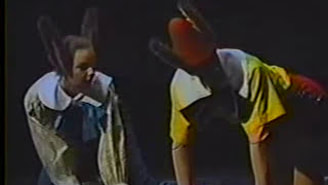
2. Gaynocchio: 40 minute parody ballet of the above. Gaypetto creates a gay puppet, narrated by a very
queer cricket. The video of uses a shortened version
of the original video, with voice overs by the composer. Please see VIII/II/3. To watch "Gaynocchio" please
click on either of the donkeys to the right:
Phinocchio (Gaynocchio) The Ballet
6. Whinnie-The-Pooh: A radio musical; 1 and a half hours; 7 scenes based on A. A. Milne (photo to the right) for S M T T B & N & piano. Commissioned by, & dedicated to, Florence Whipple & The North Shore Civic Ballet. Please see IV/V/3. 1928 illustration by E. H. Shepherd to the left (of the bear "Growler").
Whinnie-The-Pooh A. A. Milne
|
4. Off-nights at The Sometimes Café: 17# cabaret in 10 scenes; just over one hour (52 minutes & 25 seconds of music); for S M T b; 2 dancers, & N/pianist. Please see VIII/II/7 for more information. The two dance numbers are featured below, with Dana Danzel & James Spellman. The pianist is Brad Conner. James Spellman the choreograper.
To watch "Off-Nights" please click on one of the performers the right: |
Off-nights: Musical with Dance
|






